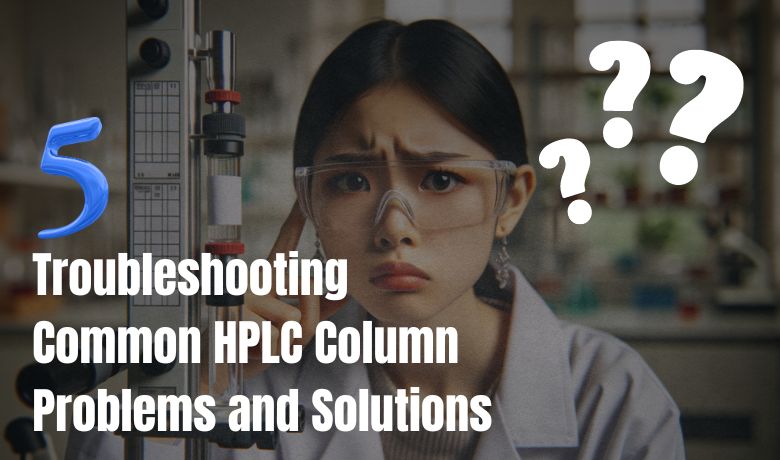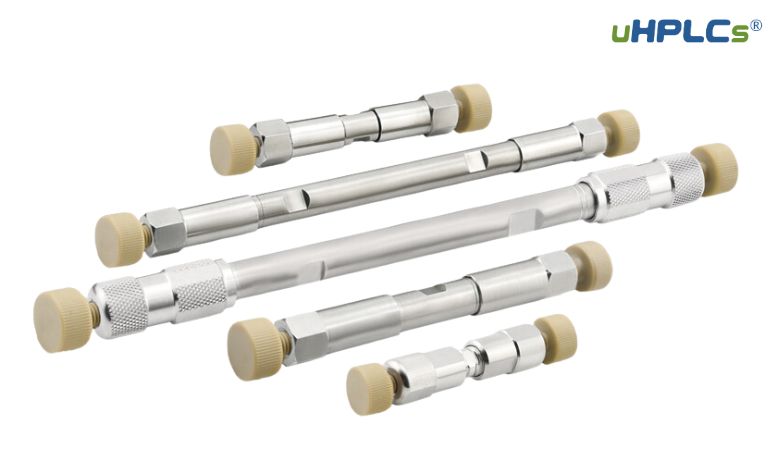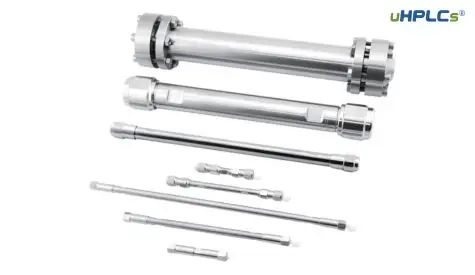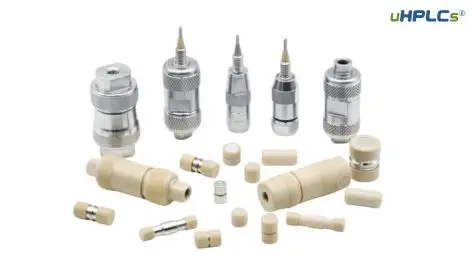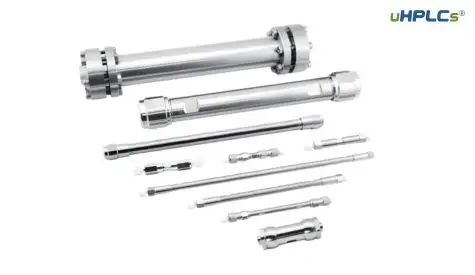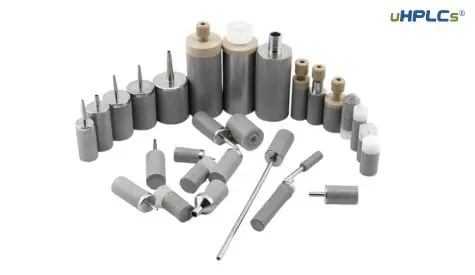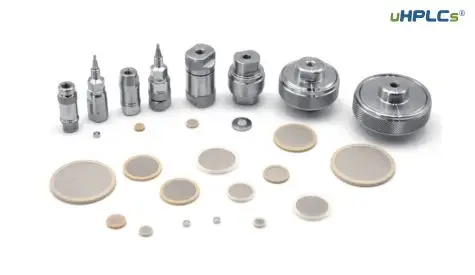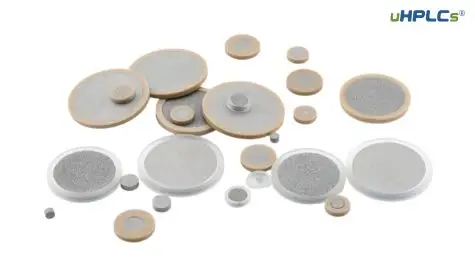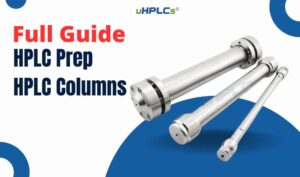1. Understanding HPLC Column Types: Reverse Phase and Normal Phase
High-performance liquid chromatography (HPLC) is a separation technique used to isolate and identify components within a mixture. A key part of HPLC is the column, which contains a packing material called the stationary phase. The mobile phase, a liquid solvent, flows through the column carrying the sample mixture. Separation of the mixture depends on interactions between the sample molecules and both the mobile and stationary phases.
There are two main types of HPLC columns based on the polarity of the stationary phase relative to the mobile phase:
1. Normal Phase HPLC:
- Stationary phase: Polar (e.g., silica gel with silanol groups – SiOH)
- Mobile phase: Less polar (e.g., n-hexane, chloroform)
- Separation principle: More polar analytes interact more strongly with the stationary phase and elute (come out of the column) later. Less polar analytes elute earlier.
2. Reverse Phase HPLC: (More Common)
- Stationary phase: Non-polar (e.g., C18 bonded hydrocarbons)
- Mobile phase: More polar (e.g., water-methanol or water-acetonitrile mixtures)
- Separation principle: More non-polar analytes interact more with the stationary phase and elute later. More polar analytes elute earlier.
Here’s an analogy to understand the difference: Imagine a race on a track. In normal phase, the track is like a wet mud path (polar), and the runners (analytes) are wearing sticky shoes (more polar). Those who get stuck more in the mud (more polar analytes) will finish later. In reverse phase, the track is like an oil spill (non-polar), and the runners are wearing regular shoes (more non-polar). Here, those who get stuck in the oil (more non-polar analytes) will take a longer time to complete the race.
Choosing the right column type (normal phase or reverse phase) depends on the properties of your sample mixture.
2. Impact of Column Specifications on Analytical Outcomes
Column specifications play a crucial role in shaping the analytical outcomes of your HPLC experiment. Here’s how different aspects of a column can impact your results:
Particle Size: Smaller particles offer higher resolution (better separation of closely related compounds) but also create higher backpressure, which can slow down analysis and potentially damage the column. Larger particles provide faster flow rates but may lead to poorer resolution.
Pore Size: The pore size of the stationary phase affects how deeply analytes can penetrate. Larger pores allow for deeper penetration and potentially stronger interactions, which can be useful for separating larger molecules. Smaller pores may be better for smaller molecules or those with complex structures.
Column Length: Longer columns generally provide better resolution but require more time for analysis and solvent. Shorter columns are faster but may not fully separate complex mixtures.
Surface Chemistry: The specific functional groups on the stationary phase can influence the selectivity of the separation. For example, a C18 column is a general-purpose reverse phase column, while a phenyl column (with aromatic rings) offers additional pi-pi interactions for separating aromatic compounds.
Here’s a table summarizing these impacts:
| Column Specification | Impact on Separation | Impact on Analysis Time |
|---|---|---|
| Particle Size | Smaller: Higher resolution, Lower flow rate | Smaller: Slower analysis |
| Pore Size | Larger: Stronger interactions (for large molecules) | – |
| Column Length | Longer: Better resolution | Longer: Slower analysis |
| Surface Chemistry | Affects selectivity | – |
By carefully considering these factors and choosing the appropriate column specifications, you can optimize your HPLC experiment to achieve the desired analytical outcomes. It’s important to consult with your specific application or refer to manufacturer recommendations for optimal column selection.
3. Enhancing Separation in Liquid Chromatography
There are several strategies you can employ to improve the separation of components in your liquid chromatography (LC) experiment:
A. Optimizing Mobile Phase:
Adjusting Solvent Composition: The polarity of the mobile phase relative to the stationary phase plays a key role. For example, in reverse phase HPLC, a more polar mobile phase will elute polar analytes faster, potentially improving separation between closely eluting peaks. You can try gradients, where the mobile phase composition changes throughout the run, to fine-tune the elution order.
Adding Modifiers: Adding small amounts of acids, bases, or salts to the mobile phase can influence analyte ionization and interaction with the stationary phase, leading to improved peak separation.
B. Optimizing Column Selection:
Choosing the Right Stationary Phase: As discussed earlier, normal phase or reverse phase may be suitable depending on your sample. Beyond that, there are various bonded phases within each category (e.g., C4, C8, Phenyl for reverse phase) that offer different selectivities for specific functional groups.
Considering Column Length and Particle Size: As mentioned previously, a longer column with smaller particles generally provides better resolution but takes more time. You can find a balance between these factors based on your needs.
C. Utilizing Advanced Techniques:
Temperature Manipulation: Running the column at a higher temperature can decrease solvent viscosity, allowing for faster flow rates or smaller particle columns. However, it can also affect analyte interactions and stability.
Pressure-Enhanced LC: This technique utilizes higher pressures to manipulate analyte selectivity, offering an additional tool for optimizing separation.
D. Sample Preparation:
- Pretreatment: Removing interfering substances from your sample before injection can significantly improve peak separation and overall analysis accuracy. Techniques like filtration or solid-phase extraction can be employed.
Tips :
- It’s often an iterative process. You may need to try different combinations of these approaches to achieve optimal separation for your specific sample mixture.
- Consult your HPLC instrument manual and consider recommendations from column manufacturers for specific applications.
4. Significance of Endcapping in Columns
In HPLC columns, endcapping refers to a process that modifies the surface of the stationary phase to improve chromatographic performance. Here’s a breakdown of its significance:
Reduced Silanol Activity: Silica gel, a common material for HPLC stationary phases, has hydroxyl groups (SiOH) on its surface called silanols. These silanols can interact with some analytes, particularly basic compounds, leading to peak tailing (broadened peaks) and inconsistent retention times. Endcapping essentially replaces these silanols with trimethylsilyl (TMS) groups, which are much less reactive. This minimizes unwanted interactions and improves peak shape and reproducibility.
Enhanced Column Lifetime: Uncapped silanols can be susceptible to attack at high pH conditions, which can degrade the silica gel and shorten column life. Endcapping protects the silica by creating a more stable surface, extending the usable life of the column.
Improved Selectivity in Mid-pH Range: At neutral pH (around 7), silanols can become ionized and develop a negative charge. This can lead to unwanted electrostatic interactions with basic analytes, affecting their retention and separation. Endcapped columns exhibit less of this effect, leading to more predictable behavior of basic compounds in the mid-pH range.
Overall, endcapping in HPLC columns contributes to:
Sharper Peaks: By minimizing silanol activity, endcapping reduces peak tailing and improves peak shape, leading to better resolution and easier quantification of analytes.
More Consistent Retention Times: Reduced silanol interactions lead to more predictable analyte behavior and consistent retention times across multiple runs.
Longer Column Life: Endcapped columns are more resistant to degradation at various pH ranges, extending their usable lifespan.
Improved Performance at Mid-pH: Endcapping allows for better separation of basic analytes in the neutral pH range, which is often used in HPLC methods.
However, it’s important to note that endcapping may not be necessary for all applications. For instance, if your analysis primarily deals with acidic compounds or operates at very low pH, an endcapped column might not offer a significant advantage.
5. Troubleshooting Elevated System Pressure and Performance Decline in HPLC
Elevated system pressure and a decline in chromatographic performance are common issues encountered in HPLC. Here are some steps you can take to troubleshoot the problem:
A. Identify the Cause of Pressure Increase:
Blocked Frit: The frit is a small filter at the inlet and outlet of the column that can get clogged with sample debris or precipitated material. Check for frit blockage by replacing the frits or attempting to flush them with a suitable solvent.
Contaminated Column: Built-up sample components or contaminants within the column can restrict flow and increase pressure. Try running cleaning procedures recommended by the manufacturer to regenerate the column. In severe cases, column replacement might be necessary.
Air Bubbles in the System: Air bubbles can cause pressure fluctuations and erratic flow. Ensure proper solvent degassing and check for leaks in the system that might be introducing air.
Vived Seals or Tubing: Worn-out seals or constricted tubing can impede flow and raise pressure. Inspect these components for signs of wear and replace them if necessary.
Mobile Phase Viscosity: Highly viscous mobile phases can lead to higher backpressure. Consider using a less viscous solvent or adjusting the mobile phase composition.
B. Investigate Performance Decline:
Loss of Resolution: Broadened peaks or insufficient separation between analytes can indicate column degradation or inappropriate mobile phase conditions. Try optimizing the mobile phase or consider column regeneration/replacement.
Retention Time Shifts: Retention times significantly different from established values might suggest changes in column chemistry or mobile phase composition. Re-equilibrate the column and ensure consistent mobile phase preparation.
C. Systematic Troubleshooting Approach:
Start with Simple Checks: Begin by checking for leaks, ensuring proper solvent degassing, and replacing any visibly damaged frits or tubing.
Evaluate Mobile Phase: Review the mobile phase composition and consider adjusting the solvent polarity or adding modifiers to improve analyte interactions.
Clean the Column: Follow the manufacturer’s recommended cleaning procedures to remove any built-up contaminants that might be restricting flow.
Column Replacement: If cleaning fails to resolve the issue, consider replacing the column, especially if it has been in use for a long time.
Advanced Techniques: If the problem persists, consult your HPLC manual or contact the manufacturer for recommendations on advanced troubleshooting techniques like pressure-washing or specialized cleaning procedures.
Anywhere, Remember, keeping a record of column performance (pressure, retention times) over time can be helpful in identifying trends and pinpointing potential problems early on.

